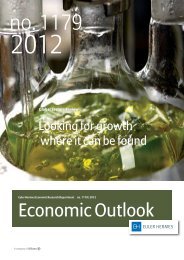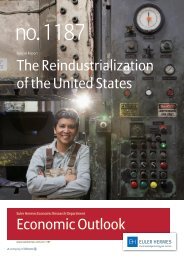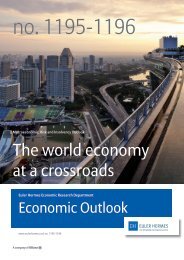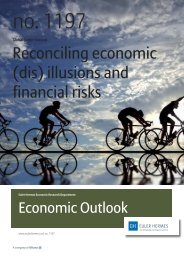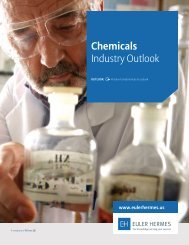Create successful ePaper yourself
Turn your PDF publications into a flip-book with our unique Google optimized e-Paper software.
<strong>Euler</strong> <strong>Hermes</strong><br />
Economic Outlook no. 6 | 2011 - Global Sectors Review<br />
Global risk<br />
A<br />
Food products and beverages<br />
No standing still<br />
Overview: a growing industry<br />
In 2010, activity in the agrifoods sector mirrored the disparities<br />
in the economic fortunes of nations, with differ<strong>en</strong>t growth<br />
patterns separating the developed countries (+6.5% by value<br />
compared to 2009 in the United States, +3.3% in Italy, +3.0% in<br />
France and +1.2% in Germany) from the emerging regions<br />
(+16.1% in China, +13.4% in Brazil). As with the recovery (+13%)<br />
in world agrifood trade, these figures need to be read in the<br />
light of the favourable price effects for various products.<br />
Curr<strong>en</strong>t situation: cyclical constraints at work<br />
A rec<strong>en</strong>t FAO/OECD report confirmed expectations of an<br />
increase in average agricultural prices over 2011-2020 (up in<br />
real terms, against the preceding decade, by 20% for grains and<br />
by 30% for meat), but to levels nonetheless still below the peaks<br />
of 2007/2008 and H1 2011. The increase in input costs,<br />
estimated at betwe<strong>en</strong> 6% and 10% for 2011, will be exacerbated<br />
not only by the upward tr<strong>en</strong>d in <strong>en</strong>ergy prices but also by the<br />
still growing volatility in other commodity prices (with the<br />
average monthly variation up by 30% betwe<strong>en</strong> 2000-2005 and<br />
2006-2010). In the short term, agrifood businesses will oft<strong>en</strong><br />
only be able to pass on these costs to their customers<br />
downstream partially, or ev<strong>en</strong> not at all. This is for two reasons.<br />
The first is the great uncertainty over sales, prompted by<br />
sluggish consumer sp<strong>en</strong>ding, and by the manifest resistance of<br />
distributors (who, like Tesco, have ambitions for their own-<br />
branded goods). The second is the ever-greater promotional<br />
activity undertak<strong>en</strong> by many groups. In the <strong>en</strong>d, the agrifood<br />
sector, which stood out by avoiding any shock from oversupply<br />
during the crisis, is facing a differ<strong>en</strong>t kind of shock, in this<br />
instance over margins, and this is a particular worry for SMEs in<br />
the sector.<br />
Outlook: actions on all fronts<br />
The classic methods for restoring profitability involve<br />
optimising industrial operations and attaining critical mass<br />
(e.g., the merger of Arla Foods and Hansa-Milch) or expanding<br />
sales (acquisition of Parmalat by Lactalis), in particular in<br />
emerging regions (acquisitions in Turkey and China by Diageo,<br />
talks betwe<strong>en</strong> Nestle and Hsu Fu Chi in China). Manufacturers<br />
continue to hone their strategic positions by targeting the most<br />
lucrative segm<strong>en</strong>ts (Nestlé’s ongoing commitm<strong>en</strong>t to<br />
nutraceuticals, with its purchase of Prometheus Laboratories)<br />
or moving into more buoyant segm<strong>en</strong>ts (ConAgra’s continued<br />
expansion of its private label business in its efforts to acquire<br />
Ralcorp; or G<strong>en</strong>eral Mills’ developm<strong>en</strong>t of dairy products<br />
activities following its purchase of Yoplait). In addition to such<br />
efforts, an increasing number of other cost-saving solutions<br />
will be pursued: portion size reduction, package redesigns, or<br />
recipe changes (replacem<strong>en</strong>t of skimmed milk powder by soya<br />
proteins by Nestlé in Vietnam), etc. _BG<br />
Major world food and beverage companies<br />
Rank Company Nationality Turnover 2010 Change<br />
USD billions 2010/20009<br />
1 Cargill USA 107.9(*) N/A<br />
2 Nestlé Switzerland 105.5 6.5%<br />
3 ADM USA 61.7(**) -10.8%<br />
4 Pepsico USA 57.8 33.7%<br />
5 Kraft USA 49.2 26.9%<br />
6 AB InBev Belgium / Brazil / USA 36.3 -1.4%<br />
7 Coca-Cola USA 35.1 13.3%<br />
8 Unilever UK / Netherlands 30.3(1) 3.7%<br />
9 Mars USA 30.0 N/A<br />
10 Tyson USA 28.4(***) 6.5%<br />
Food production growth, selected countries<br />
Change Change Change<br />
2008/2007 2009/2008 2010/2009<br />
Germany -1.7% -1.0% 0.9%<br />
Brazil 0.4% -1.4% 4.3%<br />
USA -1.3% -0.6% 4.2%<br />
France -0.7% 1.1% -0.5%<br />
Japan 0.6% 2.0% 0%<br />
Sources: national statistics<br />
(*)<br />
as of 31 may (**) as of 30 june<br />
(***)<br />
as of 30 september<br />
(1)<br />
only food activity<br />
Source: companies<br />
8



